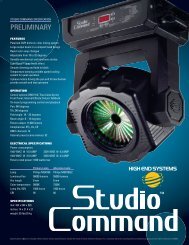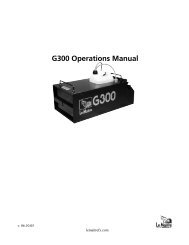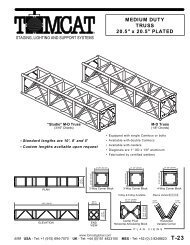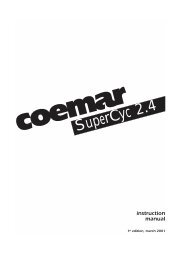Download PDF - Main Light Industries
Download PDF - Main Light Industries
Download PDF - Main Light Industries
- No tags were found...
Create successful ePaper yourself
Turn your PDF publications into a flip-book with our unique Google optimized e-Paper software.
ontour58<strong>Light</strong>ing&Sound - July-August 2006
ontourSir EltonThe legendaryElton John is backwith members ofhis original band.Steve Moles caughtup with theproduction team atthe NEC Arena,Birmingham.words and picturesby Steve MolesIt’s a long time since I’ve seen Elton John withany of his original band. In fact, the last timeI saw Nigel Olsson I was 17, visiting a flat inOnslow Gardens, South Kensington, whichNigel and many other musicians used tofrequent to talk rock - but that’s another story.Drummer Olsson and guitarist Davey Johnstoneare touchstones for me, and I’d warrant many ofElton’s fans here tonight. Their origins in Elton’sband reach back to what was, in my mind, Elton’smost fertile period. Albums such as Tumbleweed’,Madman’, and Yellow Brick Road come from anera where Bernie Taupin was seduced by thedust, texture and folklore of the American South,while Elton embraced Delta blues, honky-tonk,and most significantly, Gospel. So it was withgreat delight that I saw many songs from thatperiod on tonight’s set list.SoundFront-of-house engineer Clive Franks arrived verylate with the band, and we were lucky indeed thathe was able eventually to spare us so much time.Alan Richardson, by contrast, was all calmnessand light at the monitor console. ‘But Pablo isalso here?’ I asked rhetorically, referring toMcCartney’s house engineer. “He’s looking aftermonitors for The Storys, I think Barry Marshallasked him to do it as a favour,” said Richardson.I mention this one to commend Paul ‘Pablo’Boothroyd for his generosity of spirit; and two,because support act The Storys are aninteresting band - very much in the mould of TheEagles, they produce mellifluous vocal harmoniesover guitar-based country-folk-rock. They soundCalifornian but hale from Wales - Swansea to beprecise.Richardson has been Elton’s monitor man since‘96, “before that I’d worked for Bon Jovi, KennyLoggins,” and in fact we discovered he and I hadmet some 20 years earlier doing a show forSinatra at the Pala Trussardi in Milan.“The job falls into two distinct parts,” Richardsonbegan. “The band is five-piece - drums, perc’s,guitar, bass and keys; they are all on in-ears -Sennheiser system. Then there’s Elton.”Richardson has two pairs of wedges for Elton,Clair Brothers 12AMs tucked in beneath thekeyboard of his grand piano, and 212AMs eitherside of him. “The smaller wedge is for his vocals,the twin 12s are for band mix; he likes a full mixand very loud. We use a Beta 58A for his voice,you can hammer nails in with it and it still works!”An endorsement that might have Shure quakinga little . . . but then again?“The mic captures the punch we need, he has anunbelievable amount of power in his voice, hecan still sing louder than I yell. If my yell is at+3dB, he’ll sing at +6dB. That certainly helpswith the gain structure.”<strong>Light</strong>ing&Sound - July-August 2006 59
ontour60Crew faces, above:Clair Brothers tech, Matt Herr, pictured withfront-of-house sound engineer Clive Franks;Monitors engineer Alan Richardson;<strong>Light</strong>ing designer Kevin Bye.<strong>Light</strong>ing&Sound - July-August 2006Why the twin 12” for the band mix? “Helikes to have a lot of drums, especiallykick, in his mix. If we put the mix ona scale of ten, then piano sits at ten, kickand snare almost ten, the rest of the bandtick over at seven or eight. The only thingnot in his mix is some of the more fiddlypercussion stuff.”That all sounds like a lot of attention onElton - the band coming second - and thatband mix from the 212s must blastsomeone, even with in-ears? “The bandare the nicest guys I’ve ever worked with.They know soundcheck rehearsal time isfor them - then Elton turns up. Yes, BobBirch [Bass] does suffer from Elton’s bandmix, but he moves out the way. To behonest, very little changes day-to-day forthe band, but for Elton there can be someugly EQ just to overcome the room effectand keep feedback under control.Sometimes I look at his EQ and ask myself,can that be right? But essentially the job ishim, and with regard to what comes fromthe room, we just over-power it.”Richardson is using a Yamaha PM1D.“I’ve had it about four years now; beforethat it was a PM4000.” Your old desk wasnot the commonest of choices formonitors? “No, didn’t sound like a Midas,but we’re not looking for a ‘nice’ soundingboard. The Yamaha provides all I want;I don’t use any scenes and operate prettymuch as an analogue desk. I do love it forits facility; I use all the on-board effects,limiters and gates etc. For what I’m doingit’s perfect; because we go round theworld a lot I know I can just take my cardand always get one - it’s everywhere.In view of the late arrival of Franks outfront, I took a quick inventory of hisdomain: Yamaha PM5000 desk, AMSreverb, TC M5000, TC 2290, EventideEclipse, and a whole bunch of oldDBX160. The system is Clair Brothers I4line array, with all their system processingout front.I asked him about the desk - probably thelast large-format analogue desk to comeout of Yamaha. “Yeah, they wanted me togo digital, Alan uses one, as you know,and I did try it two years ago, for someBilly Joel/Elton shows. I did about sixshows and was just not comfortable withit. I didn’t like the sound, and because ofthe way I mix it was too slow for me, onlybeing able to grab one channel of EQ ata time, too restrictive. The PM5000 - I loveit, it does everything I want and is muchclearer sounding.”“It’s the same for the I4 system, a muchtruer sound than the old S4. Easier to mix,the separation is more distinct; with the S4you really had to work for that. I do missthe S4 for that certain low end, and in factwe are using a few S4 for just that reason.It gives the bass a certain character, andthe first few rows lacked that warmth fromthe flown I4 Subs. Overall, the I4 hasa better throw of course, and puts moreenergy everywhere in general.”We also had a brief discourse aboutcontrolling that S4 low-end character hereat the NEC where some particularlyflatulent low end can sneak up on you.Franks admitted that, “on balance the I4delivery was more preferable.”With regard to the band, Franks was veryforthright: “The fact that Nigel [Olsson] isback in the band gives the true Eltonsound.” Franks has now mixed Elton forover 30 years, so he should know. “He’sa solid drummer and has a distinct sound.Chris Subcek, his tech, tunes the kit well.”
ontourElton Notes• Elton’s regular production/tour manager Keith Bradley wasaway for the day, attending his daughter’s graduation; howcivilised. DC Parmet, part of the wider production team,managed this role on Bradley’s behalf for the day. DC (for heis known to all by this tag) and I had worked together in thepast for Tina Turner back in the eighties - he had an engaginglittle story for us: “You should check out the opening bandThe Storys,” he began. “They’re from Swansea, a good littleband, very West Coast 70s sound. Elton does like tochampion new acts - Macy Gray, John Meyer, The ScissorSisters - they’ve all opened for us. James Blunt opened for usin 2004 when no-one had ever heard of him. Elton gets all thenew releases sent to him each week - he heard The Storysand called the band’s lead singer personally.” Needless tosay, he didn’t believe who it was. “But here they are. They dogreat harmonies, really good voices.”• In keeping with the ‘low-key’ nature of the Soft LED, therewas no stage set to speak of, just slight risers for the drumsand percussion, yet the stage appeared undiminished -proving that appropriate lighting and a big enough ego onstage is enough to fill the biggest auditoria.• During Rocket Man, Elton took his piano on a musicalexcursion, venturing into some interesting Jazzimprovisations, “well I’ve never heard that before,” saidFranks at the mixing desk. It very nearly didn’t work as theaudience’s attention span waned, and the band slippeda little adrift, but he pulled it back together and receivedsome of the loudest applause of the evening when it ended.And how about that longevity? 30 years is some record: “Well I mustbe doing something right, I’ve been here since ‘72, though Elton hasnever once heard me mix.” Has he kept you busy throughout? “I’vebeen lucky enough to work for artists as talented as [Peter] Gabrieland [Robert] Plant, but Elton never really stops, in fact I’m hopingthat maybe he will next year - and then come back with a freshshow. He’d really benefit from a break.” Franks should know betterthan most, but as I said earlier, I found the current set refreshing forits re-visiting of so much of Elton’s earlier canon.So how does Franks deal with his mix, especially the super-sonicwave from Elton’s wedges? “Well, nothing really, there’s just the oldDBX160 on his voice. I’ve tried newer versions but I keep comingback to that - it just suits his voice.” Sometimes only brutalcompression will do. “He definitely has the loudest monitors, louderthan The Who - so yes, I do have to ride his vocal channel a lot. Thespill can cause a scratchy, ambient effect - I’ve tried gating his micbut it doesn’t really work. Alan [Richardson] really has those thingscranked, but you never hear on-stage feedback. In fact, Elton’sbiggest thrill is blowing up a wedge. Alan has measured 118dBApeaks at Elton’s head position.” Amazing he can still hear at all.The I4 system is tech’d by Matt Herr from Clair Brothers in the US,with the rest of the crew supplied by Audio Rent. “The only thing ofconcern here is the low end,” said Herr. “You can dig out 160Hz witha shovel, anything between 125-200Hz is pretty bad, as Clive said.But we’re putting out plenty of energy below that, and there it’sa much tighter bottom end from the I4 Subs.” Certainly enough tomake it sound big and loud. Franks achieved a considered balancefor what is a piano-focussed show where you can always hear theguitar but it never removes your head, and Elton’s vocals burned62<strong>Light</strong>ing&Sound - July-August 2006
ontour<strong>Light</strong>ing&Sound - July-August 2006 63
ontour64through whatever was playing. If criticism can be made, then it waspiano sound, Elton plays very hard and percussively a lot of thetime, and that’s how it sounded, harsh and percussive. Not that youcan lay blame at Franks’ door, this had everything to do with whathappens on stage.Richardson gave the clue on Elton’s voice, power over quality, butthen there’s plenty of so-called talent on the road that can barelysing at all. So much of what we, the public like to hear is based onidiosyncrasy, the distinct character of a certain person’s voice. Put10 violinists on stage and ask them one by one to play the samepiece and you’d be pushed to differentiate between them - butplace Elton amongst 10 of his contemporaries and there’d be nomistake; and that’s what we heard tonight.<strong>Light</strong>ingAlthough there exists a strong video element in this presentation,this was emphatically a light show, with LD Kevin Bye keeping firmcontrol on both elements. Bye is relatively new to the LD role forElton: “I’ve been designing for him since 2003,” he says, “but I’dmet him several times before as board operator when Steve Cohenwas Elton’s designer of choice. Steve gave me the show with hisblessing,” which considering Elton’s durability and output, showsa certain generosity on Cohen’s part.“The design here is done in collaboration with Benny Kirkham. I’vebeen working together with him for the last couple of years. He’sa good friend and an excellent LD, does the Dixie Chicks andAerosmith. We put this show together back on ‘05. Essentially I’mgiven a clean sheet by Elton, in all the years I’ve worked for him it’sbeen 98 per cent the LD, and one or two percent specifics fromhim.”Bye’s rig (from PRG, out of their Greenford shop), is one of thoseeasily adaptable rigs; six finger trusses fan out into the audience,<strong>Light</strong>ing&Sound - July-August 2006with short verticals off their upstage ends. Depending on the venuethis can be spread or compressed. “It’s low here because of thevenue, usually I trim the downstage end at 43ft.”Bye mentioned his slight embarrassment at discovering, “it looksvery similar to Andy Watson’s rig for Radiohead.” He needn’t beembarrassed, there’s no patent on finger trusses, and Watson’sapplication was a far darker recipe than would have suited Elton.“I also originally chose the fingers so when possible we can rig theapex point above the piano, which sits stage right of centre, butoften we play arenas to 360° or 270°, and that vanishing point aboveElton’s head just wouldn’t work for much of the audience. But this isstill fun, you can steeply rake it to make it look really big in the largerhalls - the significant point is this design has to be able to play wellin stadiums.”The rig looks to be filled with nothing but moving lights? “There’sa bit of conventional, I have lots of Molefays with colour changers,there are Source Fours on all the band members for a bit of skintone, but mostly it’s movers. VL3000 spots and Mac 2000 washesare my main lamps, the side towers have VL2000 washes, and thereare VL6s on the floor. I’m really an old VL guy and frankly you can’tbeat the VL3000. That said, the Mac 2K is one of the best washinstruments - I chose it for its very different texture.”Bye is controlling his system not from a Virtuoso - which you mightimagine from his statement about being ‘an old VL guy’ - but fromthe increasingly popular grandMA from MA <strong>Light</strong>ing. He has hisreasons: “I did want to try something different, but it’s the LEDlights really. They require a lot of channels and the effects engineon this desk is good for the kind of heavy lifting I need.” Sorry,heavy lifting? “I’ve got Pixeline running along the top of all the fingertrusses, 66 in total (we used Colour Blazers in the US, basically thesame) and they need 12 channels each. Then there’s the fibre optic
star curtain and the Soft LED curtainbehind it.”The Soft LED is a new item to me, soI spoke with Jonathan Woods, who’slooking after it. “Soft LED comes in 24ft by16ft panels, four of them span the 64ft ofElton’s stage, with two further panels, 32ftby 8ft deep attached horizontally beneathto make a 64ft by 32ft screen.” explainedWoods. “The screen is really low energy,just 25A per phase for the whole thing,though there’s a lot of processing in therewhich takes added power. Touring-wise it’sgreat, the pixels, on four-inch centres, aremounted to the cloth and attachedelectrically through a harness of what isvirtually bell-wire. Replacing a pixel clusteris a bit tricky - the easiest way is to mounta Y-frame ladder up between the two piecesof drape that sandwich the electronics;someone has to direct you by pokinga pole or something against the offendingpixel, but once located it’s just a snap-fit,a clip piercing the wires into the back. Butthey don’t fail often.”And what of rigging? “Very easy, you justneed to take a bit of time and care - lay outsome Visqueen and unload the curtain ontoit before attaching to the truss. A single 24ftby 16ft lowers into its own case for de-rig.Including the box it weighs 350lbs, so a bithefty pushing up the ramp - but a whole lotbetter than a rigid screen.”But back to Bye’s choice of the grandMAdesk, “It was a bit of a steep learningcurve,” said Bye of the desk, “but DemfisFyssicopulos programmed a lot of the LEDstuff for me. He’s a Venezuelan Greek andwas recommended to me by ACT <strong>Light</strong>ingwho supplied the desk, and he’s verygood.”And what were your sources for thestreaming video you run through the SoftLED? “Benny did most of the content. Weuse standard Catalyst material - and I dorun some camera footage, and the POV[point of view] camera on the piano.”There’s a four-camera IMAG system, in thisinstance onto the two house side-screens,but the IMAG proved a secondaryconsideration, the show on stage beingeasily big enough and engaging enough tosatisfy most seats in the house.“We also purchased a large library of stockfootage.” And in application? “The imagesare all over the place, once we discoveredwhat is possible with the Soft LED and howit looked we went for close-in sections offootage, giving a very cartoony, orwhimsical look.”Bye’s lighting is essentially big and strong,deriving the obvious cues from the music -how could it be otherwise? - and keepingattention firmly fixed upon the piano.Whimsical and cartoony are goodadjectives to describe the look of the stage.The Taupin/John interpretation of deepsouthern country comfort is painted insimple colours with occasional fantasticalovertones. Thankfully, it never strayed intothe over-egged world of a Boy Bandextravaganza, in part due to the more easilyassimilated output from the Soft LED.Steve Molesontour<strong>Light</strong>ing&Sound - July-August 2006 65









